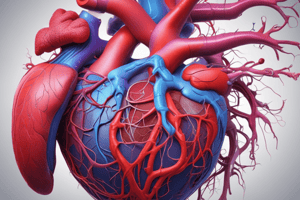Podcast
Questions and Answers
What proportion of the heart lies to the left of the median plane?
What proportion of the heart lies to the left of the median plane?
- 1/2
- 1/3
- 3/4
- 2/3 (correct)
What is the approximate weight of an adult male's heart?
What is the approximate weight of an adult male's heart?
- 300 grams (correct)
- 400 grams
- 250 grams
- 350 grams
Which of the following best describes the shape of the heart?
Which of the following best describes the shape of the heart?
- Inverted cone (correct)
- Cube-shaped
- Spherical
- Flat oval
The apex of the heart is located at which intercostal space?
The apex of the heart is located at which intercostal space?
What percentage of the body weight is the heart in an adult male?
What percentage of the body weight is the heart in an adult male?
What is the primary function of the atria in the heart?
What is the primary function of the atria in the heart?
Which layer of the heart is referred to as the myocardium?
Which layer of the heart is referred to as the myocardium?
Which of the following statements is true regarding the heart's chambers?
Which of the following statements is true regarding the heart's chambers?
What are the names of the two atria in the heart?
What are the names of the two atria in the heart?
Which layer lies beneath the myocardium?
Which layer lies beneath the myocardium?
What primary role do veins serve in the circulatory system?
What primary role do veins serve in the circulatory system?
Which characteristic defines continuous capillaries?
Which characteristic defines continuous capillaries?
In comparing vessel walls, what is a likely difference between veins and arteries?
In comparing vessel walls, what is a likely difference between veins and arteries?
What type of vessel is designed primarily for gas exchange in tissues?
What type of vessel is designed primarily for gas exchange in tissues?
Which of the following statements about the circulatory system is correct?
Which of the following statements about the circulatory system is correct?
What structure separates the atrial and ventricular contractile cells?
What structure separates the atrial and ventricular contractile cells?
Which characteristic describes the gap junctions between atrial and ventricular contractile cells?
Which characteristic describes the gap junctions between atrial and ventricular contractile cells?
What primarily supports and surrounds the heart valves?
What primarily supports and surrounds the heart valves?
Why is the fibrous skeleton significant in cardiac physiology?
Why is the fibrous skeleton significant in cardiac physiology?
Which of the following is NOT true about the electric properties of the heart's structure?
Which of the following is NOT true about the electric properties of the heart's structure?
What is the primary function of the pulmonary circulation?
What is the primary function of the pulmonary circulation?
Which statement best describes systemic circulation?
Which statement best describes systemic circulation?
What distinguishes pulmonary circulation from systemic circulation?
What distinguishes pulmonary circulation from systemic circulation?
Which area is not supplied by systemic circulation?
Which area is not supplied by systemic circulation?
What can be inferred about the relationship between pulmonary and systemic circulation?
What can be inferred about the relationship between pulmonary and systemic circulation?
Flashcards are hidden until you start studying
Study Notes
The Heart
- Located in the chest cavity, between the lungs; approximately 2/3 on the left side and 1/3 on the right side of the median plane.
- Size is roughly equal to a closed man’s fist.
- Shape resembles an inverted cone, with the base at the top and the apex situated at the 5th intercostal space along the mid-clavicular line (MCL).
- Average weight in an adult male is about 300 grams, accounting for 0.5% of total body weight.
Heart Layers
- Comprises three layers:
- Epicardium (outer layer)
- Myocardium (middle layer)
- Endocardium (inner layer)
Chambers of the Heart
- Contains two superior chambers known as the atria:
- Right atrium (RA) and left atrium (LA) serve as blood reservoirs.
- Atrial and ventricular contractile cells lack gap junctions, preventing electrical impulses from passing directly between them.
- The atria and ventricles are physically separated by a fibrous skeleton, which is nonconductive and provides structural support for the valves.
Vessels and Circulation
- Veins function as capacitance vessels, acting as reservoirs for blood.
- Capillaries are classified as continuous, allowing only small molecules to pass through due to the absence of perforations.
- The pulmonary circulation forms a closed loop, transporting blood between the heart and lungs.
- The systemic circulation encompasses a network of vessels linking the heart to all body systems, excluding the air sacs of the lungs which are served by pulmonary circulation.
Studying That Suits You
Use AI to generate personalized quizzes and flashcards to suit your learning preferences.




